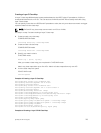
The following example matches IPv6 traffic with a DSCP value of 40.
Dell(conf)# class-map match-all test
Dell(conf-class-map)# match ipv6 dscp 40
The following example matches IPv4 and IPv6 traffic with a precedence value of 3.
Dell(conf)# class-map match-any test1
Dell(conf-class-map)#match ip-any precedence 3
Creating a Layer 2 Class Map
All class maps are Layer 3 by default; however, you can create a Layer 2 class map by specifying the
layer2 option with the class-map command.
A Layer 2 class map differentiates traffic according to 802.1p value and/or characteristics defined in a
MAC ACL.
Use Step 1 or Step 2 to start creating a Layer 2 class map.
1. Create a match-any class map.
CONFIGURATION mode
class-map match-any
2. Create a match-all class map.
CONFIGURATION mode
class-map match-all
3. Specify your match criteria.
CLASS MAP mode
match mac
After you create a class-map, you are placed in CLASS MAP mode.
Match-any class maps allow up to five access-lists. Match-all class-maps allow only one. You can
match against only one VLAN ID.
4. Link the class-map to a queue.
POLICY MAP mode
service-queue
Applying Layer 2 Match Criteria on a Layer 3 Interface
To process Layer 3 packets that contain a dot1p (IEEE 802.1p) VLAN Layer 2 header, configure VLAN tags
on a Layer 3 port interface which is configured with an IP address but has no VLAN associated with it. You
can also configure a VLAN sub-interface on the port interface and apply a policy map that classifies
packets using the dot1p VLAN ID.
To apply an input policy map with Layer 2 match criteria to a Layer 3 port interface, use the service-
policy input policy-name layer 2 command in Interface configuration mode.
To apply a Layer 2 policy on a Layer 3 interface:
1. Configure an interface with an IP address or a VLAN sub-interface
CONFIGURATION mode
724
Quality of Service (QoS)


















